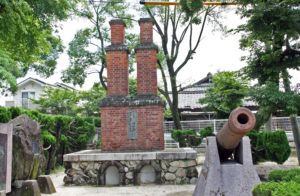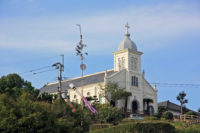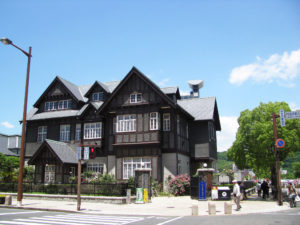Tsukiji Reflectance Furnace, in 1850
This is the Japan’s first constructed Reflectance Furnace. In the late Edo period when the
necessity of maritime defence increased, the Saga clan built the Tsukiji Reflectance
Furnace for making cast iron-made Western cannons and completed in 1850. And then,
the cast iron cannon was manufactured the first time in Japan in 1851. The reflectance
furnace was greatly contributed for initial stage of Japan’s Industrial Modernization.
 |
 |
 |
Mathew C Perry came to Uraga in 1853
In 1853, Mathew C Perry came to Uraga; the Commodore of the US navy,
who played a significant role in Japanese history, succeeded in opening Japan
to foreign countries.
 |
 |
 |
Japanese industry was 200years behind European countries at that time,
and Japanese’s industrial revolution started in Saga, Kagoshima, Nagasaki,
Kitakyushu and other places in Japan.
Naval training school in Nagasaki established in 1855
Faced with crises from overseas countries, the Shogunate established the Naval training
school in Nagasaki in 1955 with support from the Dutch.
 |
 |
 |
Excellent people from all over the Japan were gathered in Nagasaki, and Katsu Kaishu was
among them. At the training school, practical education was provided on steam engines,
navigation, operational techniques, physics, as well as artillery training and short sea navigation.
Nagasaki Port was opened to the World in 1859
Nagasaki Port was opened in 1859 for trade with the world.
And a residential areas were created for foreigners in Minami-yamate and
Higashi-yamate where overlooking Nagasaki Port.
 |
 |
 |
And in that place, houses were built for foreigners who came to Japan for
proceeding the international business in Japan.
Meiji Restoration in 1868
In 1868, Meiji Restoration, the most important event in Japanese history,
which heralded a new era of modernization in Japan.
 |
 |
 |
This revolution restored the imperial rule to Japan after more than 250years
of Tokugawa Shogunate.
Ban on Christianity was abolished in 1873
In 1873, the Meiji government abolished the ban on Christianity.
Believers who had been in hiding returned to Catholicism, and churches in various villages
were built with a variety of designs that combined Japanese and Western techniques.
 |
 |
 |
Although many Hidden Christians returned to Catholicism, there are still people in the
Nagasaki region who did not return to Catholicism and still preserve and pass on the
unique religious rituals of the Hidden era, and they are called “Hidden Christians.”
Hashima coal mining island, operated from 1875
Hashima coal mining island is an artificial reclaimed island and the site of Japan’s
first major undersea coal exploitation pioneered by Mitsubishi Heavy Industry–
and host to one of the world’s most extraordinary former mining communities.
 |
 |
 |
Hashima Coal mining began operation in 1875.
From 1890, the Coal mining was managed by Mitsubishi Heavy Industry and had
been developed as a modern Coal mining. Since, mined coal at the Hahima have
high quality, it was mainly supplied to the Yawata Steel Works for steel making.
Yawata was selected as Japanese Steel Works site in 1897
Japanese Government selected Yawata as the site for construction of Japanese Steel Works
from the 17 candidate sites across the country 1897.
The 17 candidate locations are as follows.
From the north; Aomori, Kamaishi, Shiogama, Chiba, Shinagawa, Tsurumi, Shizuoka,
Wakayama, Umeda, Onomichi, Kure, Otake, Omuta, Nagasaki, Dairi (Kitakyushu-city),
Itabitsu (Kitakyushu-city), Yawata (Kitakyushu-city)
 |
 |
 |
The reasons selected Yawata are;
Coal and limestone are available nearby
Convenient sea and land transportation
Large construction area
Rich industrial water
Yawata belongs to current Kitakyushu-city
And Construction activity of Steel Works was commenced in 1898.
Japan’s modern Steel industry in 1901
Japanese industry at the end of 19th century was 200 years behind.
After Mathew C Perry came to Japan in 1853, Japan’s industrial
Revolution was started.
 |
 |
 |
Japan’s modern Steel industry was started as Yawata Steel Works
at Higashida district in Kitakyushu in 1901.
Since then, the Steel Works greatly contributed to Japan’s industrial modernization.
And Japan became the world’s leading industrialized country in only 100 years.
Dr. Albert Einstein visited Moji, Kitakyushu in 1922
Dr. Albert Einstein who awarded Nobel Prize in Physics stayed here. It was built by the
Mitsui Co., Ltd in 1921 as a reception centre and to provide accommodation for VIP’s.
It is now designated as an important cultural property.
Albert Einstein (1879-1955), one of the world’s most famous theoretical physicists, stayed here
during his visit to Japan with his wife in 1922, and his room is displayed exactly as it was at that time.
 |
 |
 |
 |
 |
 |
